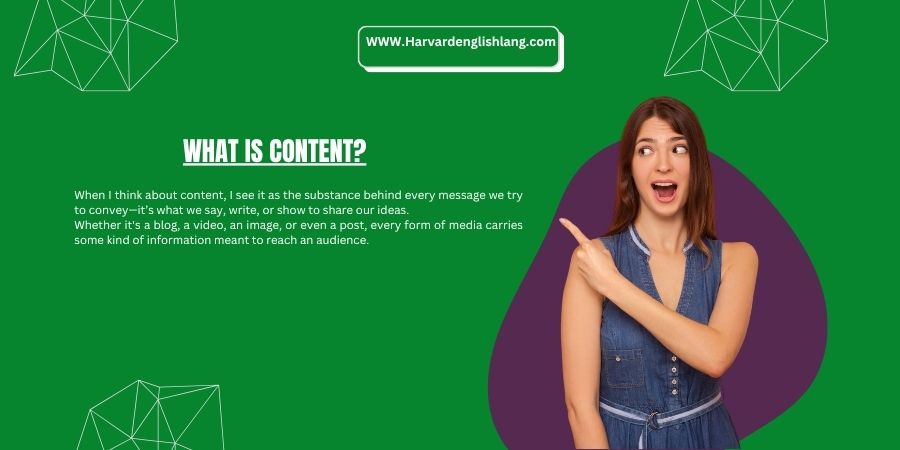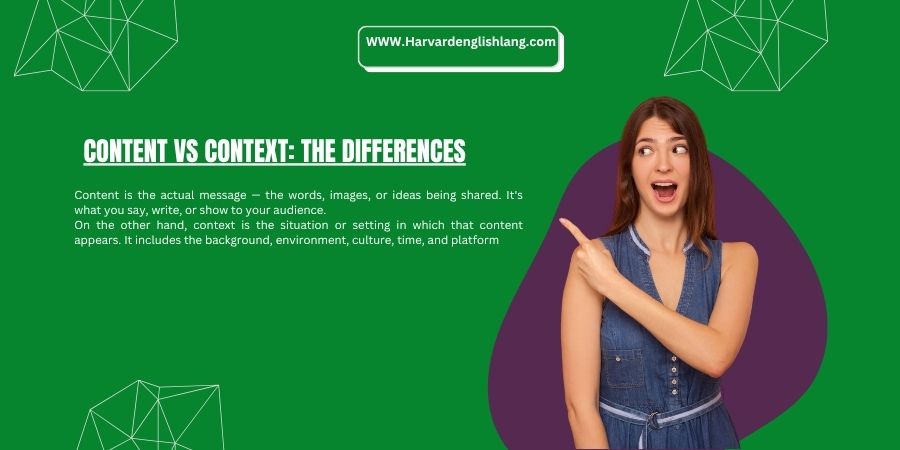In my experience working in marketing and with various brands, I’ve often seen people confuse content with context. It may seem like a small difference, but it makes a big impact.
You can create the most high-quality videos, text, or pictures and feel like your message is clear. But if it’s not placed in the right setting or places, your audience may not really understand it.
Content is what you say—your words, your information, the stuff you put out. But context is what’s around that content—it’s the meanings, the feeling, and the setting that shapes how the message is received and consumed. Without it, your ideas might be misunderstood.
There was a time I helped a business that published blog posts daily. They thought their strategy was successful because they were active and constantly creating.
But the problem wasn’t what they were saying—it was how and where they were saying it. They didn’t listen to their audience, or notice the components of the conversation that actually mattered.
They were focused on content but ignored context, which led to major misunderstandings and a drop in engagement.
That experience helped me realize the importance of pairing content with its right context—making sure that every message is not just delivered, but understood by the people you’re trying to reach.
One of my favorite quotes is by George Bernard Shaw, who said, “The illusion that communication has taken place is the single biggest problem.”
That stayed with me, especially when talking to teams or clients where ideas didn’t connect. If your ideas, no matter how valuable, clear, or explained, aren’t placed in the right context, the entire communication may fall apart.
To avoid this, we need to ask better questions, truly hear the feedback, and be aware of the roles, terms, and concepts in use.
Whether you’re running a business, posting on social media, or working on your next online campaign, always remember—content is the power, but context is the proof that it matters.
Why is There Confusion?
From my work in digital storytelling and team training, I’ve seen firsthand how confusion between content and context often leads to poor communication.
People tend to focus so much on creating good material that they forget the importance of the setting it’s delivered in. When your audience receives a message without understanding the full situation or the platform it’s meant for, a misunderstanding is almost guaranteed.
One message might work in one place but completely fail in another. This happens because the two—content and context—are deeply connected, yet they serve different purposes.
The key to avoiding this is recognizing that both are a vital part of every message. A video, blog post, or campaign may seem strong on its own, but if the context isn’t clear, it just doesn’t work.
I’ve learned through experience that even the smallest oversight—like ignoring the tone expected by the audience on a specific platform—can ruin otherwise effective communication.
Understanding when, where, and how something is said is just as important as what is being said. Once you truly grasp this balance, things begin to flow naturally and messages land exactly where they’re supposed to.
You Might Also like: Backward or Backwards: Which is Correct?
What is Content?

When I think about content, I see it as the substance behind every message we try to convey—it’s what we say, write, or show to share our ideas.
Whether it’s a blog, a video, an image, or even a post, every form of media carries some kind of information meant to reach an audience.
As someone who works in digital communication, I’ve learned that content is the building blocks of how we connect. No matter how simple or complex, what matters is how effectively your content communicates what you want to express.
Types of Content
Written content:
written, blog, article, post, ebook, newsletter, report, copy, whitepaper.
Visual content:
visual, image, infographic, video, graphic, design, photo,
Audio content:
audio, podcast, music, voiceover, narration, interview,
Interactive content:
interactive, quiz, poll, survey, form, calculator, tool, app,
How Content Changes Meaning
The meaning of content can shift depending on several factors like tone, context, and audience.
For example, the same message might be received differently depending on the culture, setting, or situation in which it’s shared. The speaker’s intention and the way the content is delivered also influence how it’s understood.
Even small changes in language, emphasis, or structure can affect the perception of the communication.
The platform and medium—whether it’s written, spoken, or visual—add another layer that shapes meaning. Understanding the background, mood, and form helps make sure the content is interpreted as intended.
What is Context?
When we think about content, it’s important to also consider the environment it exists in. From my experience as a teacher and writer, I’ve seen how the setting or surrounding details can change how people see a message.
The context acts like a frame around a picture, shaping how we understand what’s being shown. It provides the background, gives more information, and helps reveal the meaning clearly.
For example, even a simple phrase can change depending on the things that include tone, place, or time. Context is what makes the full idea come alive—it’s everything around the content that gives it value.
Audience:
The audience matters because people from different backgrounds may interpret the same message in different ways.
Purpose:
Your purpose also plays a role—are you trying to inform, entertain, or persuade?
Platform:
The platform you choose, whether it’s social media, a classroom, or a business meeting, changes how your content is received.
Types of Context
Historical Context
- Influenced by past events or time periods
- Adds meaning based on historical background
Situational Context
- Based on the specific moment or condition
- Meaning changes depending on where and when it’s said
Social Context
- Shaped by relationships and social roles
- Depends on who is involved and how they relate to each other
How Context Changes Meaning
The meaning of any content can shift depending on the context it is placed in. A single word, image, or message might be understood differently based on the situation, audience, location, or time.
For example, a joke that makes sense in one culture may be offensive in another. Similarly, a statement said in a serious setting carries a different tone than when said casually.
This is because context provides the background and conditions that help us interpret the content more accurately.
You Might Also like: Appendices or Appendixes? Clarifying Usage
Content vs Context: The Differences

Content is the actual message — the words, images, or ideas being shared. It’s what you say, write, or show to your audience.
On the other hand, context is the situation or setting in which that content appears. It includes the background, environment, culture, time, and platform.
All of which affect how the message is received. While content delivers the core information, context gives it meaning. Without the right context, even strong content can lead to misunderstandings.
| Feature | Content | Context |
| Definition | The actual message or information | The background or setting around the content |
| Form | Words, images, videos, posts | Environment, culture, time, location |
| Purpose | To communicate ideas or messages | To help interpret and understand content |
| Focus | What is being said or shown | Where, when, and how it is presented |
| Example | A blog post, photo, or video | Social media platform, audience mood |
Balancing Content and Context
Why Content Alone Isn’t Enough
Even well-written content can lose its meaning if it’s not placed in the right context. Without knowing the audience, time, or setting, a message may be misunderstood. Context helps people see the full picture, making the content more relevant and impactful.
How Content and Context Work Together
Content and context work like partners. Content is what you say, and context is how and where you say it. When combined properly, they create a powerful message that speaks clearly and connects with the audience on a deeper level.
Tips for Getting It Right
Know Your Audience
Understanding your audience helps you shape your content and context to match their needs, interests, and background. This ensures your message is clear, relevant, and engaging.
Match Content to Context
- Adjust tone and style to fit the setting.
- Use language that suits the audience.
- Choose the right platform for your message.
- Consider timing and cultural relevance.
- Align visuals and format with the environment.
Simple Tools and Tips for Better Communication
Content Calendars:
Help you plan and organize your message for the right time and audience.
Analytics Tools:
Show what content is working and where improvements are needed.
Feedback:
Offers insights from your audience to make your communication clearer and more effective.
Mistakes to Avoid
Common Issues with Ignoring Context
Miscommunication:
The message may be taken the wrong way without the right context.
Engagement Issues:
People may not relate or respond if the content feels out of place.
Reputation Damage:
Ignoring context can make a message seem tone-deaf or insensitive.
When Focusing Too Much on Content Goes Wrong
Irrelevant Content:
Strong content may still fail if it doesn’t fit the situation or audience.
Lost Opportunities:
Without context, chances to connect or influence can be missed.
Origins of the Words “Content” and “Context”
Origins of the Word “Content”
The word content has an interesting history. It comes from the Latin term “contentus,” which meant satisfied or contained.
Later, in the Middle Ages, it made its way into the English language, where it began referring to things held or contained within something else—like a book, container, or letter.
As someone who’s worked in publishing, I’ve seen firsthand how content was once just simple written material in a physical form.
But over time, the meaning evolved. It started to include all kinds of ideas, information, and experience shared with an audience.
Today, content is shared through digital media in various formats like videos, images, and text.
Whether it’s an article, a podcast, or a blog post, the content you see is carefully created to communicate something meaningful. It’s amazing how something once hidden inside a book is now reaching global audiences through ever-changing platforms.
Origins of the Word “Context”
When I first came across the word “context” during my early studies in language and communication, I didn’t realize how deeply rooted it was in history.
Its origin can be traced back to the Latin term “contextus,” which means “joining together” or “woven together.” This term entered English in the 15th century, where it was used to describe the parts of a text or discourse that surrounds a particular passage.
These surrounding elements help shed light on its meaning and are essential for correctly grasping the significance of any statement.
I remember analyzing a piece of writing in college, and realizing how the background and settings dramatically changed how we interpret the ideas presented.
In today’s modern usage, the term has broadened beyond just literature. It now includes the circumstances, events, and influence that shape how information is understood.
In my experience as a content strategist, I’ve learned that the full understanding of a message derives not only from what is said but also from how, when, and where it is said.
The context truly provides meaning—it gives light to the text and helps the audience see the whole picture. Without this, even well-written statements can fall flat. The joining of all these elements is what makes communication effective and impactful.
Conclusion
In my experience working with different brands and platforms, I’ve learned that balancing both content and context is not just smart—it’s crucial.
A well-crafted message may carry strong substance, but without the right context, it often loses meaning and fails to connect with the audience.
Your approach must be flexible, your tone shaped by the situation, and your ideas tailoring to the platform. This alignment provides more than just clarity—it makes your communication truly resonant.
I’ve seen businesses avoid major pitfalls simply by learning to fit their messaging to the moment.
The goal is always to create something engaging, something that leaves a powerful impression.
Effective communication means making ideas clear, messages aligned, and the impact great. Whether you’re sharing insights on social media or crafting a corporate memo, understanding how context shapes your content will help ensure that your voice doesn’t get lost. This practice not only strengthens communication, but also builds deeper trust with your audience—something every creator, leader, or writer should strive for.

A communication coach with a background in public speaking and business English. He helps professionals refine their English for workplace success.
